Pages 3 and 4 provide a short individual description for each of the patterns, arranged
in alphabetical order; illustrations are the same ones shown in previous pages, with a few
additional details.
Bergamasche
Location: Bergamo
No.of cards: 40
This is a typical northern Italian pattern, with a rather simple graphic look,
and double-headed courts, still preserving some details related to the early
Lombard tarot cards (see the Tarot gallery, page 5).
The ace of Cups, in the shape of a fountain topped by a blindfolded cupid, was
inspired by the crest of the ruling Sforza family (second half of the 15th century),
while the courts of the Batons suit carry maces instead of staffs, matching those
of the Cary-Yale tarot deck, of similar age. |
 |
 |
Among the distinctive features, the Coins pips are coloured in red and black, and
the ace of the same suit is a simple yellow/orange circle; in a recent edition by Modiano the traditional circle has been replaced by a large single pip (on the left). The ace of Batons, instead,
features the word " VINCERAI" ("you shall win"), see also the
expressions gallery. |
The Bergamasche pattern is also known because of two couples of additional
cards found in some editions: they show an arrangement of numbers from 1 to 8 and sometimes
from 1 to 10. They are used to help the players keep account of their score,
in prticular when playing Scopa. Sometimes the colour of their
backs is different from the rest of the deck. |
 |
Bresciane
Location: Brescia
No.of cards: 52
Another northern Italian pattern, with a peculiar narrow width, but with an
ordinary length.
They do not look too much different from the previous style, although their suit signs are
slightly more elaborate, while their court personages are single-headed, looking more naive,
almost disproportioned (big arms, small legs), with uncoloured faces.
The Bresciane cards are the only Italian pattern which does not exist in a 40-card
version.
|
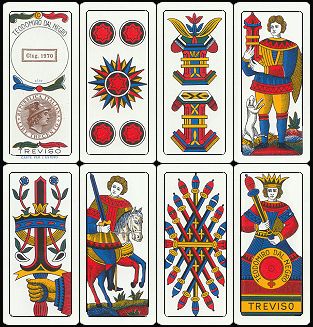 |
Fiorentine - see Toscane, page 4
Genovesi
Location: Genoa and Liguria region
No.of cards: 36 - 40 - 52
French-suited pattern, rather similar to the Franco-Belgian one.
The size of the deck is therefore wider than other regional patterns, more or
less as a Poker deck.
The pip cards are rather simple, with no index, while the courts are
elegantly decorated, and wear the same clothing as French courts. The few
differences with the latter pattern as explained in detail in the
French gallery; however, the most evident is the
absence of indices.
|
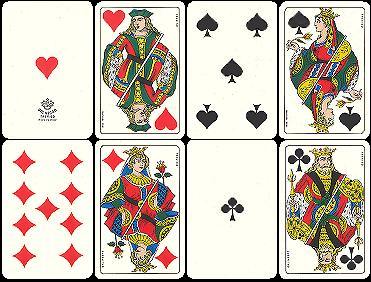 |
Among Italian regional cards, only the Genovesi have a diagonal
doubling line.
The Genovesi cards exist in three versions, though the 36-card one has become
almost obsolete.
Lombarde (or Milanesi)
Location: Milan (and its surroundings)
No.of cards: 40
Another pattern with French suits, but this time the cards are quite slimmer.
Their illustrations too are completely different from the previous ones, more delicate and
rich in details, almost reminiscent of the Swiss French-suited style.
Courts are double-headed, with a horizontal doubling line. |
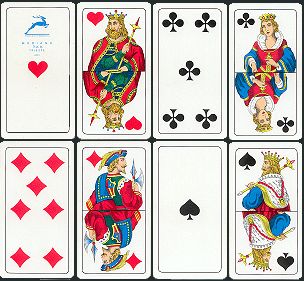 |
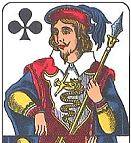 |
Among the typical features, the knave of Clubs wears a cloak featuring a winding snake,
a symbol which appears in the crest of Milan since the 15th century (detail on the left,
from E.Pignalosa's edition, c.1950). |
These cards are the only Italian pattern to be made in a variety named
Lombarde Estero (more or less "foreign Lombarde"), for other countries,
in particular for the Italian-speaking cantons of Switzerland, neighbours to Lombardy.
Curiously, this export variety has the same illustrations as the standard deck, but two small
indices appear in the corners, and court cards have the name of the character
vertically spelled in full, as shown in detail on the right. The Lombarde Estero
design is also described in the Swiss gallery. |
 |
Napoletane
Location: Naples (and other southern areas)
No.of cards: 40
|
A well-known pattern, due to its great popularity, the Napoletane is probably
one of the least ancient styles, having developed into its present look probably
during the second half of the 1800s; the hair and moustache fashion worn by many
characters (especially the kings) was quite typical in those years.
Coins have a star-shaped pattern, with a tiny face in each pip; the ace
features a double-headed eagle (in all other southern patterns it is single-headed).
Courts are single-headed. |
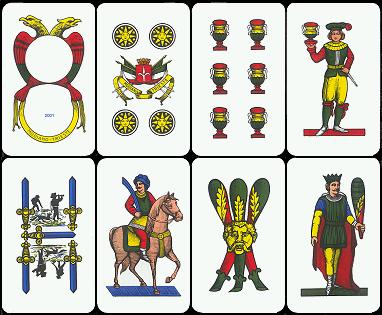 |
Among the cards of the deck with peculiar details, the most recognizable is
the 3 of Batons, featuring a grotesque face, that in modern editions wears a big moustache; this detail was probably borrowed from the early Portuguese-like patterns that were used in the south of Italy; similar faces often decorated some of the pip cards belonging to the suits of Swords and Batons, in which the suit signs form intersections. The 5 of Swords usually features the silhouette of small rural scenes (e.g. sowing, or other farming activity); the cavalier of the same suit is a Moor, wearing a turban
and holding a scimitar (the latter detail is curiously found in German patterns, as well).
Piacentine
Location: Piacenza (and most central and northern areas)
No.of cards: 40
Also the Piacentine cards are a well-known pattern, and they are probably used
in an even wider area than the Napoletane. Their size is quite longer and thinner
than any other central-southern pattern, almost suggesting a connection with northern ones.
In fact, the pattern named after the city of Piacenza sprang from Aluette cards, a pattern typical of western France, yet with Spanish suits (see page 31 for details). The Piacentine gained popularity in most areas of central Italy, that once belonged to the Papal State; only Tuscany proved impermeable to this pattern, having already developed one of its own. The Piacentine are also played with in the north of Italy, where they coexist with more specific local patterns. Therefore, today this is probably the pattern most widely spread in Italy. |
 |
The earliest examples known date back to the late 1700s, when their similarity to Aluette cards was very close. Their design kept developing during the first half of the following century, so that a real standard was not reached before the late 1800s. Also the number of cards, which in the French deck is 48, was reduced to 40, so to match the common composition of most other Italian patterns.
 |
The Piacentine cards were created with single-headed courts (see picture on the left), as any other pattern with a Spanish origin. Then, during the first half of the 20th century, double-headed ones began to replace the more traditional design, which was completely abandoned by the mid 1900s. This is the only Italian regional pattern that underwent a similar change, whereas in other countries, such as France and Germany, all regional patterns gradually switched to the double-headed design. |
Despite their long evolution, the Piacentine's illustrations still maintain some details from the Aluette cards, such as the king of Coins, who holds an axe.
The considerable richness of details and colours, especially in court cards, undoubtly makes the Piacentine design the most eye-catching pattern among Italy's central-southern group, likely accounting for its great popularity.
Among its distinctive features, the ace of Batons, a thick stump in place of the cudgel found in other patterns of this group, is easily recognizable.
Instead the ace of Coins features a large crowned eagle with a round space in front of its body.
 |
In early 19th century editions (right) the eagle carried a coin, i.e. an actual pip, while the 4 of the same suit (left) bore the tax stamp. Later on, the stamp was moved to the
ace, where a blank circle replaced the coin. |
The empty part of the 4 of Coins was then filled with a city crest, usually the one of the manufacturer's own hometown, or with the logo of the firm (samples below). |
 |

 |
In 1972 the tax was discontinued, and the white space remained blank. A
number of manufacturers have recently started filling up again this space, either with their own logo or with a coin (left).
Piacentine cards are also printed by a number of foreign manufacturers, for local use by immigrants and players of Italian descent. |
These editions faithfully follow the standard design, with one curious exception: the cherub-less ace of Swords printed by Grimaud (France), shown on the right in comparison with the traditional subject. The same French edition also refers to this pattern as "Bologna type" on the box of the deck, which may be misleading.
|
 |
Piemontesi
Location: Piedmont
No.of cards: 36 - 40 - 52
Closely related to the Genovesi, this French-suited pattern has a similar
size, a similar variety of compositions (36, 40 or 52 cards), and courts looking
not too different from the Genoese and Franco-Belgian styles, although their doubling
line is horizontal, easily recognizable from the latter. |
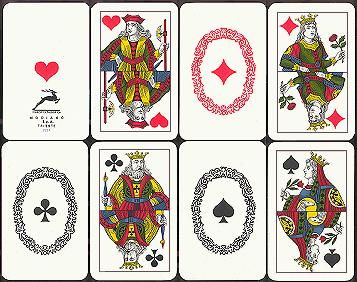 |
 |
A further distinctive feature is that three of the four aces feature a decorative girdle around
the plain suit sign. In most editions, the ace of Hearts is the only one without
this decoration, due to the fact that it bore the tax stamp; however, in some recent
editions all four aces are decorated.
The girdle may be of the same colour of the suit (two red and two black), otherwise all
of them are black.
The picture on the left shows a comparison of red aces by Modiano and Dal Negro (top row),
Masenghini and Demon's (bottom row). |
Primiera Bolognese
Location: Cento (Ferrara)
No.of cards: 40
Several features make the Primiera Bolognese unique. This is the southernmost among the northern patterns, the one whose illustrations have probably changed less than any other playing card design, and also the one whose use today is restricted to the smallest geographic area.
The name Primiera is also that of a popular trick-taking game mentioned by 16th century sources and commonly played in those times. In fact, this is the only regional pattern
in Italy that bears the name of a game, while all the others are identified after their geographic location alone. The game has now disappeared, and the use of the pattern has been maintained
merely in the town of Cento, just north of Bologna.
The Primiera Bolognese sprang directly from Bologna's tarot (see regional tarots); in particular, the four aces, 6s, 7s, knaves, cavaliers and kings are exactly the same ones, but since the deck follows the ordinary 40-card scheme, the pip cards from 2 to 5 had to be added, and the tarot's queen was dropped. |
 |
The shape of the deck is rather slim, and illustrations are simple though elegant, with deep colours, and suggest a close similarity with the early design of the 16th-17th centuries.
The courts are double-headed, but actually all the subjects, including the pip cards, are
arranged symmetrically (i.e. all of them could be considered double-headed),
with the only exception of the ace of Coins, a simple black pattern framing the space
for the tax stamp. Curiously, prior to the late 1700s, when this pattern was still single-headed, the four knaves were female, as they wore a long gown, despite their not very feminine bust. When the design adopted the double-headed scheme, the lower half of the illustration became no longer visible, and the look of the knave turned definitely masculine.
The ace of Swords has a rather unusual curved shape, ending with
an eagle's head (see picture); in early single-headed editions both this ace and that of Batons were held by a hand in the lower half of the illustration, now lost. Another peculiar feature is that the staves (pips) in the suit of Batons are bound together by their ends.
page 1
regional patterns - part I |
page 2
regional patterns - part II |
page 4
regional patterns - part IV |
page 5
fancy patterns |